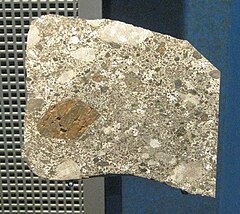Mesosiderite
| Mesosiderite | |
|---|---|
| — Class — | |
 Vaca muerta mesosiderite. | |
| Type | Stony-iron |
| Subgroups |
|
| Composition | sulphides (troilite) |
| Total known specimens | 208 |
 Chinguetti mesosiderite | |
Mesosiderites are a class of
They are a rare type of meteorite; as of November 2014 only 208 are known (of which 56 come from Antarctica) and only 7 of these are observed
At Vaca Muerta in the
The most recent fall of a mesosiderite occurred at Dong Ujimqin Qi in China, on September 7, 1995, where three large pieces with a total mass of 129 kilograms (284 lb) fell. The fall of the Estherville mesosiderite in Iowa, US occurred on May 10, 1879. After a brilliant fireball had been seen, a shower of several large masses and many small fragments fell, totaling 320 kilograms (710 lb). The fall at Lowicz in Poland on March 12, 1935, yielded many (more than 50) fragments with a total weight of 59 kilograms (130 lb). The other observed mesosiderite falls occurred in 1842 at Barea (Spain), in 1880 at Varamin (Iran), in 1933 at Dyarrl Island (Papua New Guinea), and at Patwar (India) in 1935.[4] The legendary Chinguetti meteorite is also supposed to be a mesosiderite.
The asteroid 16 Psyche is a candidate for the parent body of the mesosiderites.[5]
See also
References
External links
- Mesosiderite images from Northern Arizona University
- Mesosiderite images from Meteorites Australia
